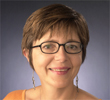6 A&S Physicists Awarded Breakthrough Prize
Our universe is dominated by matter and contains hardly any antimatter, a notion which still perplexes top scientists researching at CERN’s Large Hadron Collider. The Big Bang created equal amounts of matter and antimatter, but now nearly everything—solid, liquid, gas or plasma—is…


 M. Cristina Marchetti, the William R. Kenan Jr. Professor of Physics in
M. Cristina Marchetti, the William R. Kenan Jr. Professor of Physics in